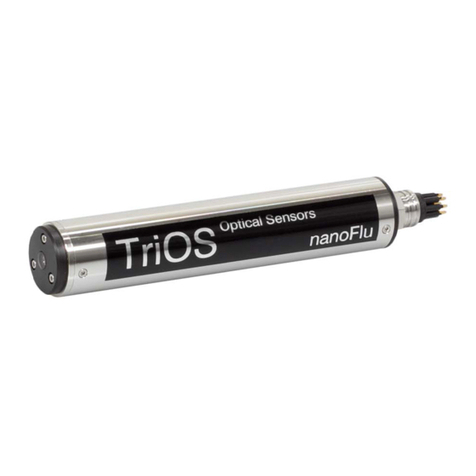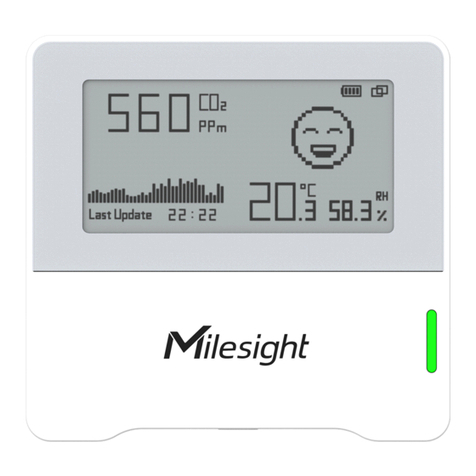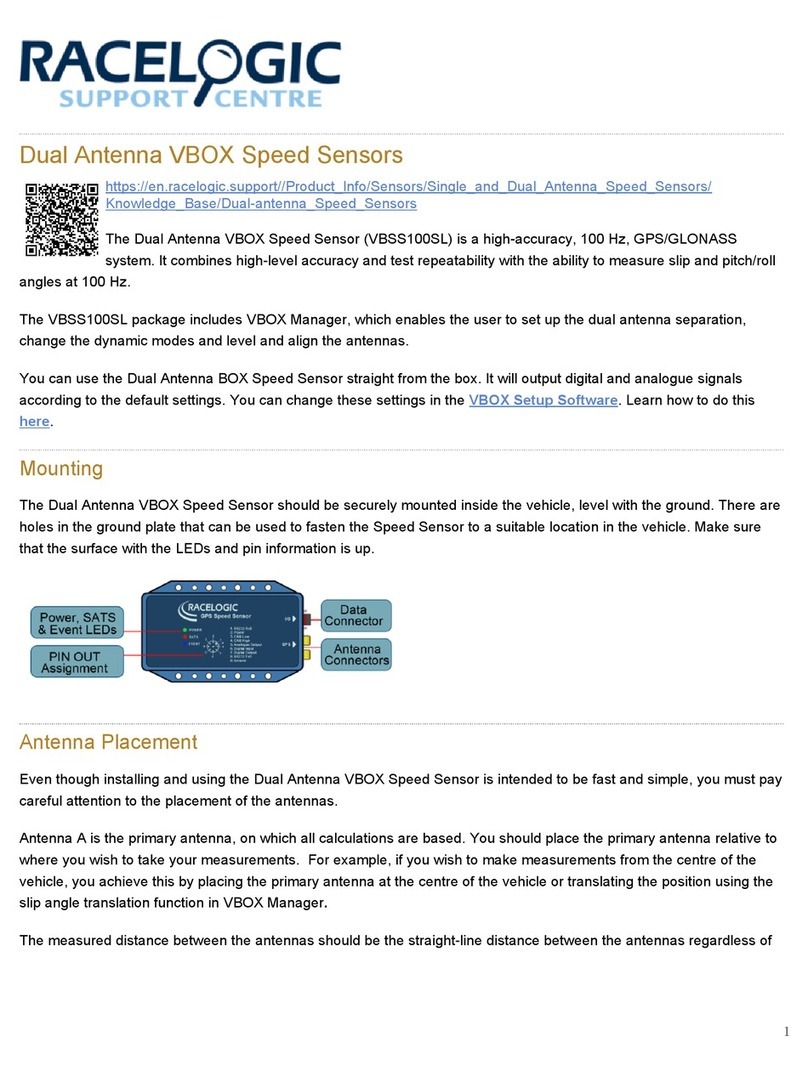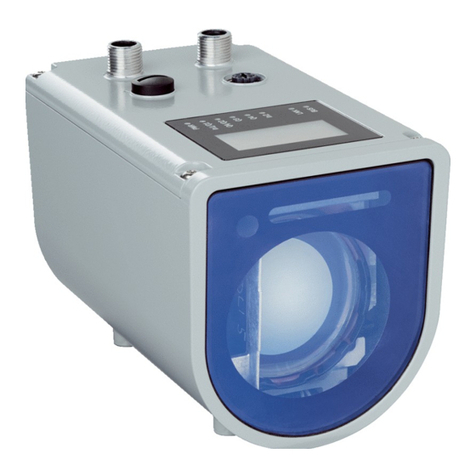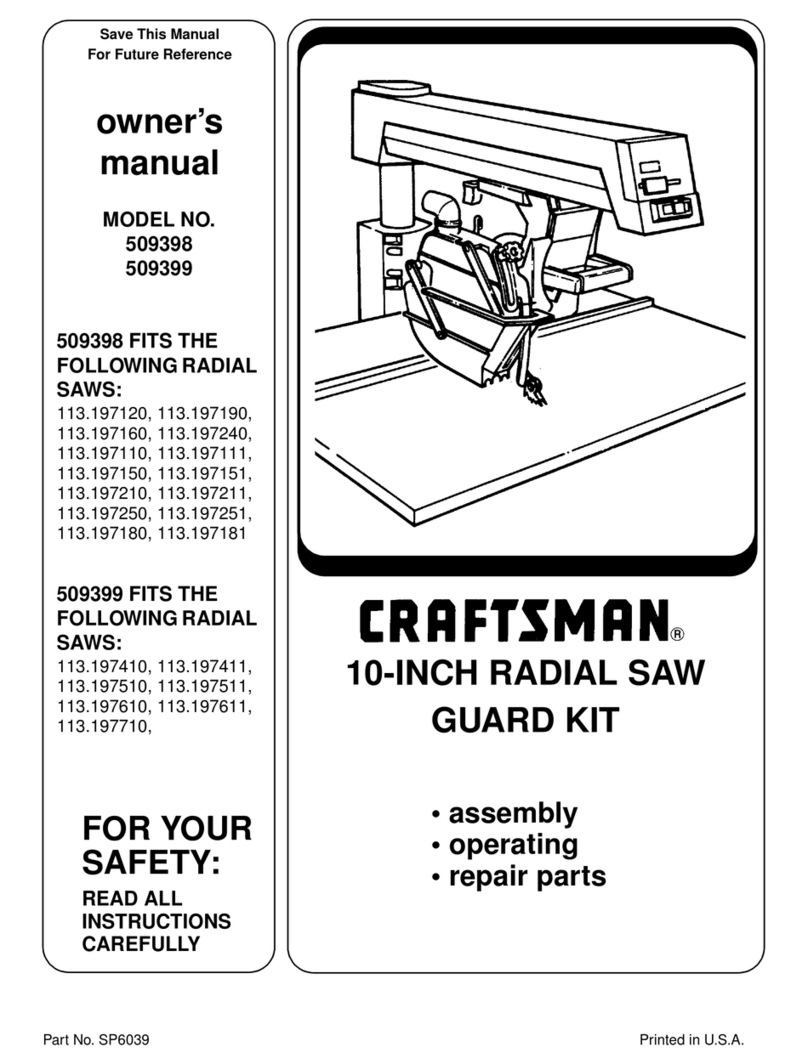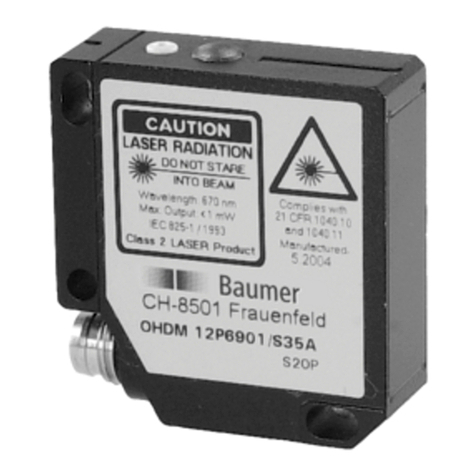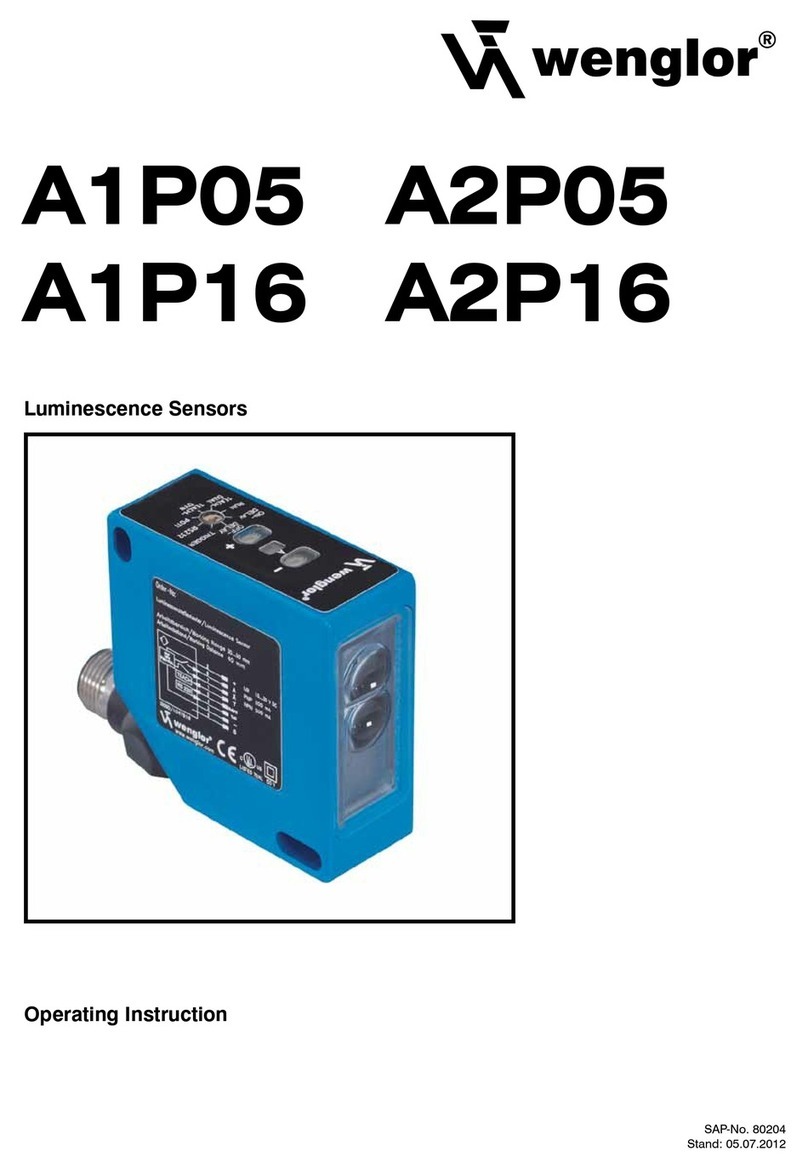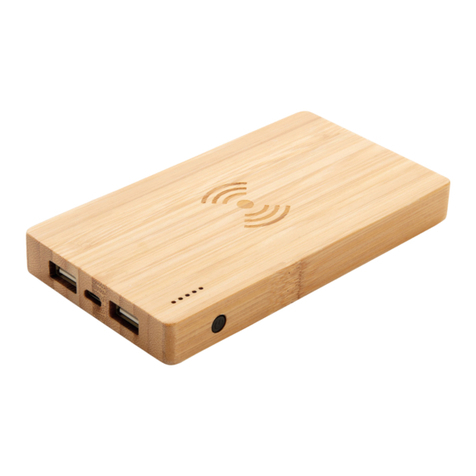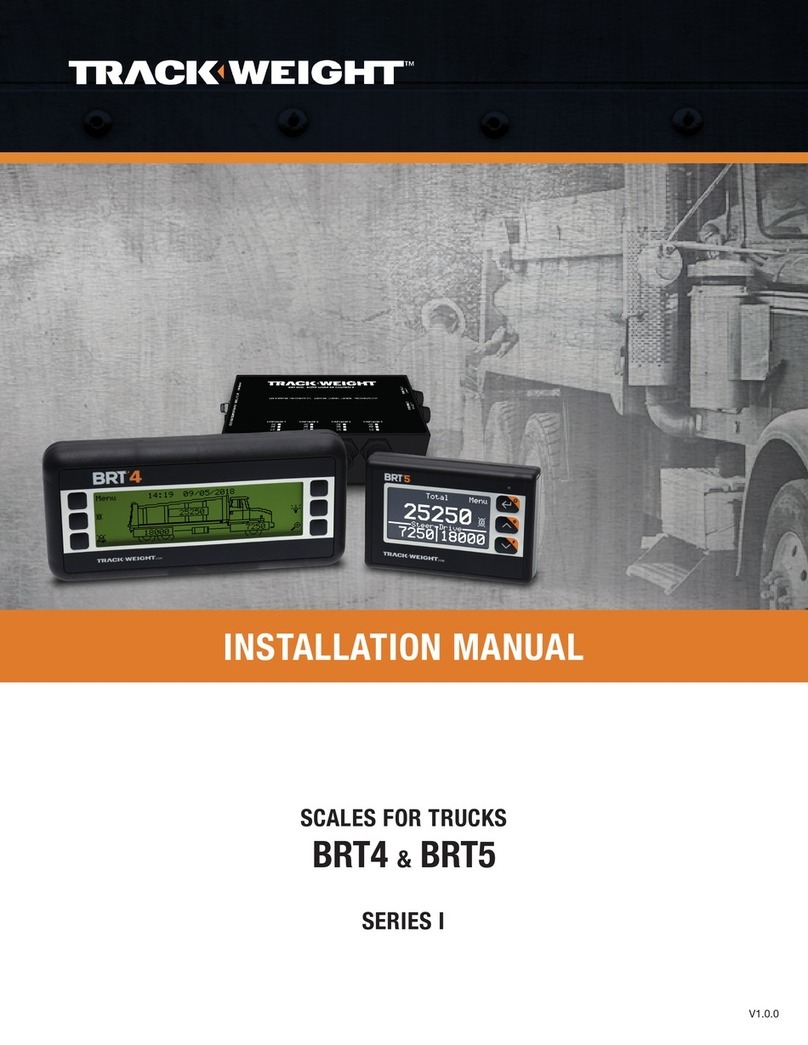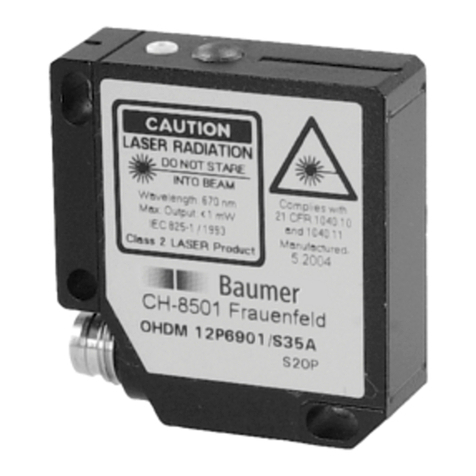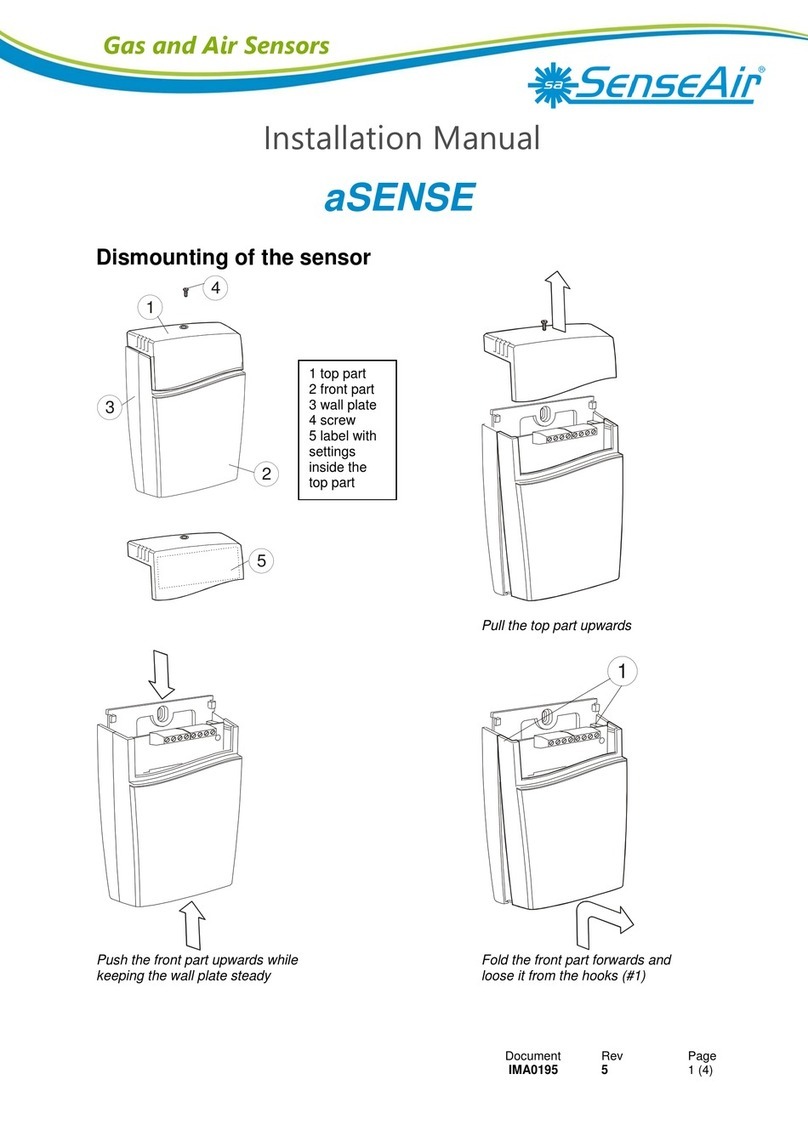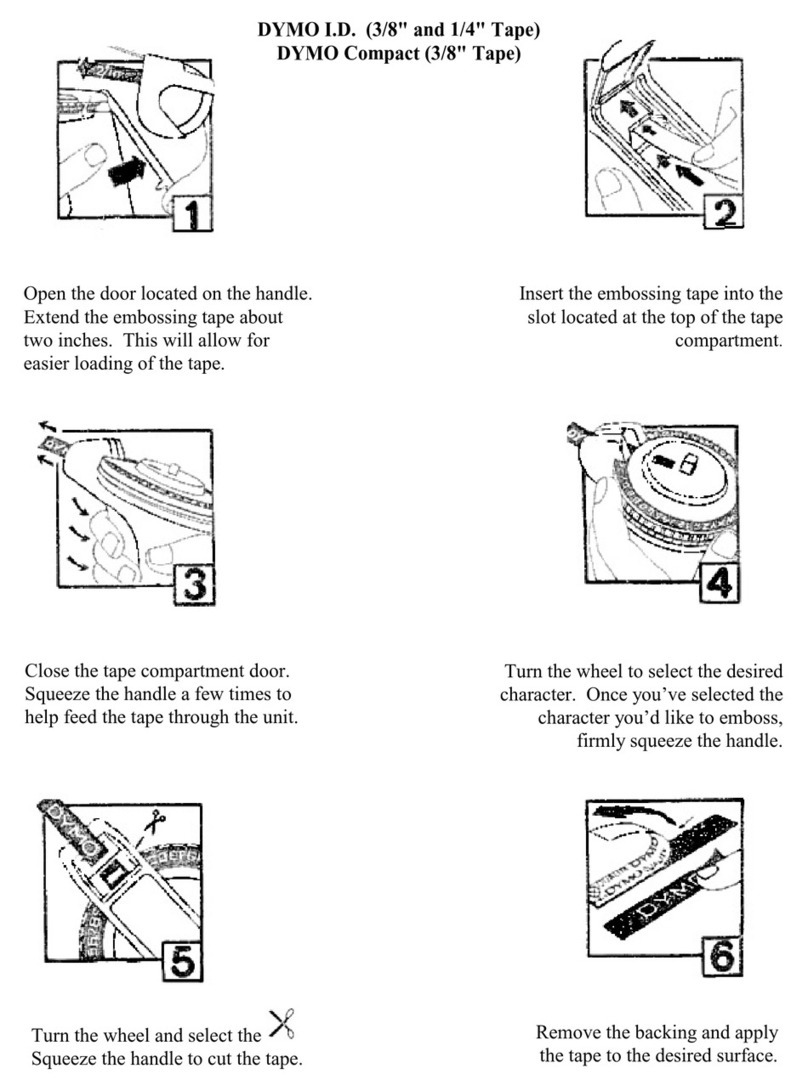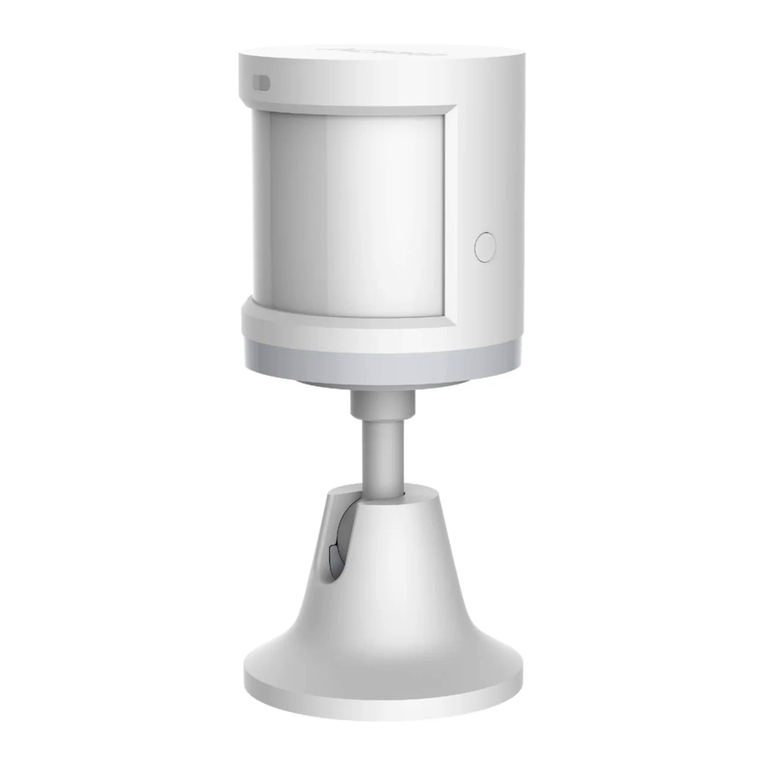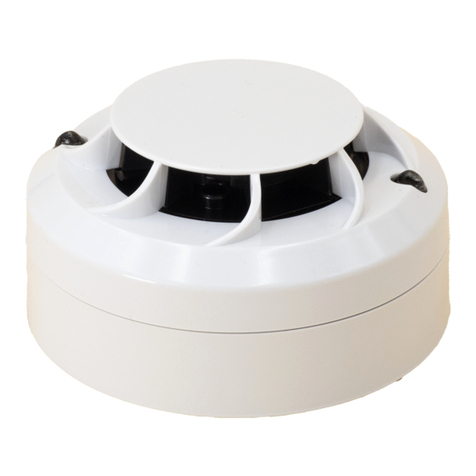triOS Dissolved Oxygen User manual

Dissolved Oxygen
OPERATING INSTRUCTIONS


1
TABLE OF CONTENTS
Table of Contents
1 General Information 2
1.1 Introduction 2
1.2 Health and Safety Information 3
1.3 Warnings 4
1.4 Users and Operating Requirements 4
1.5 Intended Use 4
1.6 Disposal Information 5
1.7 Certicates and Approvals 5
2 Introduction 6
2.1 Product Identication 6
2.2 Scope of Delivery 7
2.3 Measurement Principle and Design 7
3 Commissioning 8
3.1 Electrical Installation 8
3.1.1 Fixed Cable with M12 Industrial Plug 8
3.2 Interfaces 8
3.2.1 Serial Interface 8
4 Use 9
4.1 Normal Operation 9
4.2 Bypass Installation 9
4.3 Support Tube Installation 10
5 Calibration 12
5.1 Two-Point Calibration 12
5.1.1 Oset Calibration 12
5.1.2 Slope Calibration 12
5.2 One-Point Calibration 13
5.3 Measurement Properties 13
5.3.1 Inuences on the measurement 13
5.3.2 Temperature Compensation 13
5.3.3 Atmospheric pressure 13
5.3.4 Salinity 13
6 Malfunction and Maintenance 14
6.1 Cleaning and Upkeep 14
6.2 Maintenance and Inspection 14
6.2.1 Changing the Membrane Cap 15
6.3 Troubleshooting 15
6.3.1 Implausible Values 15
6.4 Returns 15
7 Technical Data 16
7.1 Technical Specications 16
7.2 External Dimensions 17
8 Accessories 18
8.1 TriBox 3 18
8.2 TriBox Mini 18
9 Warranty 19
10 Customer Service 20
11 Contact 21
12 Keyword Index 22
Annex 24

2D01-903en201912 Manual Dissolved Oxygen
General Information // Dissolved Oxygen
Use
Use
Calibration
Calibration
Malfunction &
Maintenance
Malfunction &
Maintenance
Commissioning
Commissioning
Introduction
Introduction
General
Information
General
Information FAQ
FAQ Technical Data
Technical Data
Warranty
Warranty
Customer
Service
Customer
Service
Contact
Contact
Keyword Index
Keyword Index
Accessories
Accessories
1 General Information
1.1 Introduction
Welcome to TriOS.
We are glad that you have chosen to purchase the Dissolved Oxygen sensor.
The Dissolved Oxygen sensor is based on luminescent optical technology. With only low calibration requirements and thanks
to an ultra low power technology, the sensor meets the demands of eld works and short or long term campaigns. Without
oxygen consumption, this technology allows you an accurate measure in all situations and especially in very low oxygen con-
centrations. The “smart” Oxygen sensor stores calibration and history data within the sensor. This allows you a “plug and play”
system without re-calibration.
In this manual, you will nd all of the information you will need to commission the Dissolved Oxygen sensor. Technical speci-
cations, detection limits and dimensions can be found in chapter 7.
Please note that the user is responsible for complying with local and national regulations on the installation of electronic de-
vices. Any damage caused by incorrect use or unprofessional installation will not be covered by the warranty. All sensors and
accessories supplied by TriOS Mess- und Datentechnik GmbH must be installed and operated in accordance with the speci-
cations provided by TriOS Mess- und Datentechnik GmbH. All parts were designed and tested in accordance with international
standards for electronic instruments. The device meets the requirements of the international regulations on electromagnetic
compatibility. Please use only original TriOS accessories and cables to ensure reliable and correct operation of the devices.
Before using the device, read the manual carefully, and keep this manual on hand so it can be used later. Before commissioning
the sensor, please make sure that you have read and understood the following safety precautions. Always make sure that the
sensor is operated correctly. The safety precautions described on the following pages should ensure the reliable and correct
operation of this device and any additional associated devices and should prevent injuries to yourself or other persons and
damage to other equipment.
If the translation is at all dierent from the original German text, the German version is binding.
Copyright Notice
All of the content in this manual, including texts, photographs and graphics, are protected by copyright. Unless expressly
stated otherwise, TriOS Mess- und Datentechnik GmbH is the owner of the copyright. Violations of this copyright will be pun-
ishable according to section 106 of the German Copyright Act. The violator will be warned at his own expense and must pay
compensation.
NOTICE

3
D01-903en201912 Manual Dissolved Oxygen
Dissolved Oxygen // General Information
Use
Use
Calibration
Calibration
Malfunction &
Maintenance
Malfunction &
Maintenance
Commissioning
Commissioning
Introduction
Introduction
General
Information
General
Information FAQ
FAQ Technical Data
Technical Data
Warranty
Warranty
Customer
Service
Customer
Service
Contact
Contact
Keyword Index
Keyword Index
Accessories
Accessories
1.2 Health and Safety Information
This manual contains important information about health and safety rules. This information is labelled according to the in-
ternational specications of ANSI Z535.6 (“Product safety information in product manuals, instructions and other collateral
materials”) and must be followed strictly. The distinction is made between the following categories:
Tip / Useful Information
Can result in damage to property
Warning / may lead to serious injury or death
Caution / may cause moderate injury
Electromagnetic Waves
Devices that radiate strong electromagnetic waves can inuence the measurement data or result in a malfunction of the sen-
sor. Avoid using the following devices in the same room as the TriOS sensor: mobile phones, cordless phones, transmitters/
receivers and other electrical devices that produce electromagnetic waves.
Reagents
Follow the safety and operating instructions of the manufacturer when using reagents. Observe the valid Hazardous Materials
Ordinance for reagents (German GefStoV)!
Biological Safety
Liquid waste may be a biohazard. Therefore, you should always wear gloves when working with such materials. Please observe
the current biological material ordinance (German BioStoV)!
Waste
When handling liquid waste, observe the regulations on water pollution, drainage and waste disposal.
Danger warning / will lead to serious injury or death
DANGER
WARNING
CAUTION
NOTICE

4D01-903en201912 Manual Dissolved Oxygen
General Information // Dissolved Oxygen
Use
Use
Calibration
Calibration
Malfunction &
Maintenance
Malfunction &
Maintenance
Commissioning
Commissioning
Introduction
Introduction
General
Information
General
Information FAQ
FAQ Technical Data
Technical Data
Warranty
Warranty
Customer
Service
Customer
Service
Contact
Contact
Keyword Index
Keyword Index
Accessories
Accessories
1.3 Warnings
• This sensor has been developed for use in industry and science. It should only be used for the measurement of
aqueous solutions, e.g. process waste water, river water or sea water.
• Sensors made from stainless steel must be cleaned immediately after coming into contact with salt water or other
corrosive substances (e.g. acids, alkalis and chlorine-based connections.)
• The material resistance should be checked after every use.
• Do not cut, damage or change the cord. Make sure there are no heavy objects on the cord and that the cord is not
folded. Make sure that the cord is not placed near hot surfaces.
• If the sensor cord is damaged, it must be replaced with an original part by the customer service of TriOS Mess- und
Datentechnik GmbH or by an authorized TriOS workshop.
• Stop operation of the sensor if excessive heat develops (i.e. if it is hot to the touch). Switch o the sensor immediately
and unplug the power cord from the power supply. Please contact your dealer or TriOS customer service.
• Never try to disassemble or modify a part of the sensor if such a procedure is not explicitly described in this manual.
Inspections, modications and repairs may only be done by the dealer or by qualied experts authorized by TriOS.
Devices from TriOS Mess- und Datentechnik GmbH meet the highest safety standards. Repairs to the device that involve the
replacement of the connecting cable must be done by TriOS Mess- und Datentechnik GmbH or a workshop authorized by
TriOS. Faulty, improper repairs can result in accidents and injuries.
Stainless steel sensors are not intended for use in sea water or in high chloride concentrations (corro-
sion). Only sensors made of titanium can be used in these cases.
1.4 Users and Operating Requirements
The Dissolved Oxygen sensor was developed for use in industry and science. The target group for the operation of the Dis-
solved Oxygen sensor is technically skilled sta in plants, sewage treatment plants, water plants and institutes. Operating this
device often requires the handling of hazardous substances. We assume that the operating personnel are familiar with dealing
with dangerous substances based on their professional training and experience. Operating personnel must be able to correctly
understand and implement the safety labels and information on the packaging and in the package inserts of the test kits.
1.5 Intended Use
The Dissolved Oxygen sensor is designed exclusively to take oxygen measurements as described in this manual. For this pur-
pose, the sensor is an immersion sensor, to be used underwater or with ow cells. Please note the technical data of the acces-
sory parts. Other uses do not comply with the intended use.
NOTICE
TriOS does not guarantee the plausibility of measurement values. The user is responsible for
monitoring and interpreting the values.
DANGER

5
D01-903en201912 Manual Dissolved Oxygen
Dissolved Oxygen // General Information
Use
Use
Calibration
Calibration
Malfunction &
Maintenance
Malfunction &
Maintenance
Commissioning
Commissioning
Introduction
Introduction
General
Information
General
Information FAQ
FAQ Technical Data
Technical Data
Warranty
Warranty
Customer
Service
Customer
Service
Contact
Contact
Keyword Index
Keyword Index
Accessories
Accessories
The compact and robust stainless steel or titanium sensor is particularly well suited to the following typical areas of application:
• Industrial and municipal sewage treatment plants
• Wastewater management (nitrication and de-nitrication)*
• Surface water monitoring
• Fish farming, aquaculture
• Drinking water monitoring
The use of other media can damage the sensor. For the use of the Dissolved Oxygen sensor in media other than those specied
this manual, please contact the customer service of TriOS Mess- und Datentechnik GmbH ([email protected]).
According to current scientic knowledge, the device is safe to use when it is handled according to the instructions in this
user manual.
1.6 Disposal Information
At the end of the device’s life or use, the device and its accessories can be returned to the manufacturer for environmentally
friendly disposal for a fee. (See address below.)The preceding professional decontamination of the device must be proven with
a certicate. Please contact us for more information before you send the device back.
Address of the manufacturer:
TriOS Mess- und Datentechnik GmbH
Bürgermeister-Brötje-Str. 25
D-26180 Rastede
Germany
Telephone: +49 (0) 4402 69670 - 0
Fax: +49 (0) 4402 69670 – 20
1.7 Certicates and Approvals
This product meets all of the requirements of the harmonized European standards. It therefore meets the legal requirements
of the EU guidelines. TriOS Mess- und Datentechnik GmbH conrms the successful testing of the product by axing the CE
marking. (See Annex.)
Avoid touching the membrane, because it can become scratched or dirty. If this happens, the func-
tionality of the device can no longer be guaranteed.
NOTICE

6D01-903en201912 Manual Dissolved Oxygen
Introduction // Dissolved Oxygen
Use
Use
Calibration
Calibration
Malfunction &
Maintenance
Malfunction &
Maintenance
Commissioning
Commissioning
Introduction
Introduction
General
Information
General
Information
FAQ
FAQ Technical Data
Technical Data
Warranty
Warranty
Customer
Service
Customer
Service
Contact
Contact
Keyword Index
Keyword Index
Accessories
Accessories
2 Introduction
2.1 Product Identication
There is a rating plate on the sensor with the following information that you can use to uniquely identify the product:
Serial number
Product type
Power supply
Interface
In addition to the product bar code, the rating plate includes the TriOS Mess- und Datentechnik GmbH logo and the quality
label.
Please note that the specications given here are for illustration purposes only and may be dierent depending on the version
of the product.
The Dissolved Oxygen sensor applies the luminescence-based optical measurement technology and measures reliably and
accurately. With low consumables and maintenance required, the Dissolved Oxygen sensor gives an immediate return on the
investment. The only intervention required is to replace the Membrane Cap every two years.
The sensor can even be used in applications with very weak ow of water.
The sensor oers the following advantages:
• Low operating costs due to reduced maintenance work (no electrolyte changes)
• Greater calibration intervals due to low drift behaviour
• No polarization voltage required
• High measuring accuracy, even for low concentrations
• Rapid response times
• No minimum inow (no oxygen consumption)
The sensor features excellent interference immunity thanks to the integrated preamplier and digital signal processing. The
measured value for dissolved oxygen is automatically compensated with the temperature, air pressure, and salinity (salt con-
tent), and transferred without interference to the connected display unit and controller via a digital interface. The membrane
cap is easy to replace, meaning the sensor is very easy to maintain. The current calibration data is saved directly in the sensor
electronics. As a result, the Plug and Play function of the system is enabled without the need for recalibration. The sensor also
includes a log book containing the last ten successful calibrations in the form of a ring buer.
Assembled
in Europe
Serial No 903-17-A7135
Type DO VA 2m
Sensor Power
12 VDC
Sensor Interface
Modbus RTU
TriOS eCHEM Serie
903-17-A7135

7
D01-903en201912 Manual Dissolved Oxygen
Dissolved Oxygen // Introduction
Use
Use
Calibration
Calibration
Malfunction &
Maintenance
Malfunction &
Maintenance
Commissioning
Commissioning
Introduction
Introduction
General
Information
General
Information
FAQ
FAQ Technical Data
Technical Data
Warranty
Warranty
Customer
Service
Customer
Service
Contact
Contact
Keyword Index
Keyword Index
Accessories
Accessories
2.2 Scope of Delivery
The shipment contains the following components:
Sensor
Operating Instructions
Accessories (if applicable)
Keep the original packaging in case the device needs to be returned for maintenance or repairs.
2.3 Measurement Principle and Design
Stainless steel membrane
cap
Membrane cap seal
Cable bushing

8D01-903en201912 Manual Dissolved Oxygen
Calibration
Calibration
Malfunction &
Maintenance
Malfunction &
Maintenance
Introduction
Introduction
General
Information
General
Information
FAQ
FAQ Technical Data
Technical Data
Warranty
Warranty
Customer
Service
Customer
Service
Contact
Contact
Keyword Index
Keyword Index
Accessories
AccessoriesUseCommissioning
Commissioning // Dissolved Oxygen
3 Commissioning
This chapter deals with the commissioning of the sensor. Please pay particular attention to this section and follow the safety
precautions to protect the sensor from damage and yourself from injury.
Before the sensor is put into operation, it is important to ensure that it is securely attached and all of the connections are
connected correctly.
3.1 Electrical Installation
3.1.1 Fixed Cable with M12 Industrial Plug
Ensure correct polarity of the operating voltage or otherwise the sensor may be damaged.
1. RS-485 A
2. RS-485 B
6. Power 12 VDC
7. Ground (Power + Ser. Interface)
NOTICE
The sensor is ready for initial startup once it is connected to your terminal, settled in its accessory of assembly and the param-
eterization has been carried out on the display unit.
The sensor must be operated with 12 VDC.
NOTICE
3.2 Interfaces
3.2.1 Serial Interface
The sensors serial interface is RS-485.
For the RS-485, voltages of –5 V to +5 V with respect to the ground are possible. RS-485 uses a dierential signal where the
sign-negative potential of the A line is put on the B line. The A-B dierence is decisive where the transmission is most resistant
to interactive interference signals.
The used protocol is Modbus RTU. A detailed description of the Modbus protocol commands can be found in the Annex.

9
D01-903en201912 Manual Dissolved Oxygen
Calibration
Calibration
Malfunction &
Maintenance
Malfunction &
Maintenance
Introduction
Introduction
General
Information
General
Information
FAQ
FAQ Technical Data
Technical Data
Warranty
Warranty
Customer
Service
Customer
Service
Contact
Contact
Keyword Index
Keyword Index
Accessories
Accessories
Use Commissioning
Dissolved Oxygen // Use
4 Use
The Dissolved Oxygen sensor can be operated with any of the TriOS controllers. Instructions for correct installation can be
found in the controller manual.
4.1 Normal Operation
Once the sensor is connected to your Controller, the sensor is settled in its accessory of assembly and the parameterization has
been carried out on the display unit, the sensor is ready for initial startup.
Remove the black cap of protection (by holding the sensor head downward and by unscrewing the hood towards the right).
The sensor is delivered dry and the Membrane Cap must be rehydrated so that the measures are optimized. After dry storage,
rehydrate the membrane for a 12 hours period (one night) in clear water.
Standard operation of the sensor is carried out by immersing it into the medium. The sensor can either hang freely or be
mounted at 45°.
For measurement, you must eliminate bubbles trapped under the membrane. Presence of chlorine will distort the measure
(overestimation of dissolved oxygen level).
During the introduction of the sensor to the measurement environment, wait for the sensor’s temperature stabilization before
starting a measurement. To optimize a sustainable functioning of your probe, we recommend you to respect a frequency of
measurements above 10 seconds.
Optical oxygen sensors do not carry out any continuous measurements. To extend the operating life of the optical membrane,
the measurement interval can be set to a value superior to 10 seconds.
4.2 Bypass Installation
TriOS oers a compact modular FlowCell System to install the sensor into your application. This system allows exible adaption
to the application and the possibility to expand your range of sensors.
The membrane is vulnerable to chemicals (organic solvents, acids, peroxide) and mechanical treat-
ments (impact, abrasion, tearing).
NOTICE

10 D01-903en201912 Manual Dissolved Oxygen
Use // Dissolved Oxygen
Use
Use
Calibration
Calibration
Malfunction &
Maintenance
Malfunction &
Maintenance
Commissioning
Commissioning
Introduction
Introduction
General
Information
General
Information
FAQ
FAQ Technical Data
Technical Data
Warranty
Warranty
Customer
Service
Customer
Service
Contact
Contact
Keyword Index
Keyword Index
Accessories
Accessories
4.3 Support Tube Installation
TriOS provides two adapter pieces for installing the TpH-D sensor in existing tube systems:
• NPT1 adapter ZM12 (incl. cap nut ZM13)
• G1 adapter ZM11 (incl. cap nut ZM13)
1
1
2
2
3
3
4
4
A A
B B
C C
D D
E E
F F
TriOS GmbH
Tel. 04402-69670-0
DIN ISO 2768-f (Oberfl.) Maßstab: DIN A4 (Gewicht) 1 kg
(Werkstoff, Halbzeug)
G1-Adapter Ponsel O2
Name
Witte
Datum
25.01.2018Bearb.
Änder.
Ursprung:
TriOS GmbH
Bgm.-Brötje-Str. 25
26180 Rastede ZM101710
Ersatz für: Ersatz durch:
Blatt
1 von
1
ENTWICKLUNG
Freig.
iProperties - Übersicht - Kommentar:
In der Zeichnung:
iProperties - Übersicht - Kommentar:
Im Modell
Weitergabe sowie Vervielfältigung dieses Dokuments, Verwertung und Mitteilung seines Inhalts sind verboten,
soweit nicht ausdrücklich gestattet. Zuwiderhandlungen verpflichten zu Schadenersatz. Alle Rechte vorbehalten.
The reproduction, distribution and utilization of this document as well as the communication of its contents to others
without express authorization is prohibited. Offenders will be held liable for the payment of damages. All rights reserved.
ZM131710
Mechanik
OR 25x2,5 NBR
00B00 4136
ZM111710
Mechanik
Halterohr
Assembly process
1
1
2
2
3
3
4
4
A A
B B
C C
D D
E E
F F
TriOS GmbH
Tel. 04402-69670-0
DIN ISO 2768-f (Oberfl.) Maßstab: DIN A4 (Gewicht) 1 kg
(Werkstoff, Halbzeug)
G1-Adapter Ponsel O2
Name
Witte
Datum
25.01.2018Bearb.
Änder.
Ursprung:
TriOS GmbH
Bgm.-Brötje-Str. 25
26180 Rastede ZM101710
Ersatz für: Ersatz durch:
Blatt
1 von
1
ENTWICKLUNG
Freig.
iProperties - Übersicht - Kommentar:
In der Zeichnung:
iProperties - Übersicht - Kommentar:
Im Modell
Weitergabe sowie Vervielfältigung dieses Dokuments, Verwertung und Mitteilung seines Inhalts sind verboten,
soweit nicht ausdrücklich gestattet. Zuwiderhandlungen verpflichten zu Schadenersatz. Alle Rechte vorbehalten.
The reproduction, distribution and utilization of this document as well as the communication of its contents to others
without express authorization is prohibited. Offenders will be held liable for the payment of damages. All rights reserved.
ZM131710
Mechanik
OR 25x2,5 NBR
00B00 4136
ZM111710
Mechanik
Halterohr
9
Version 1.1
Update: January 2016
AQUALABO CONTROLE
35 Rue Michel Marion –56850 CAUDAN, FRANCE
Tel.: +33(0)2 97 89 25 30 –Fax: +33(0)2 97 76 55 72
Short pole
Long pole
The long poles are available in elbow version, for installations in aeration basin, and straight, for
applications in open channel. Every pole is equipped with an elbowed shutter and with waterproofness
joints. The lower part includes a nozzle which is adapted to the sensor what assures its mechanical
support.
Elbowed shutter
Ring shutter
Nozzle
The short pole is available in 2 versions :
- version with elbowed shutter. The nozzle of support is included in
the offer.
PF-ACC-C-00266
STRAIGHT SHORT POLE
FOR OPTOD SENSOR (1495
mm, ELBOWED SHUTTER)
PF-ACC-C-00267
STRAIGHT SHORT POLE
FOR PHEHT SENSOR (1495
mm, ELBOWED SHUTTER)
PF-ACC-C-00268
STRAIGHT SHORT POLE
FOR C4E/NTU SENSOR
(1495 mm, ELBOWED
SHUTTER)
- version with shutter for mounting with chain The nozzle of
support is included in the offer.
PF-ACC-C-00269
STRAIGHT SHORT POLE
FOR OPTOD SENSOR (1550
mm, RING SHUTTER)
PF-ACC-C-00270
STRAIGHT SHORT POLE
FOR PHEHT SENSOR (1550
mm, RING SHUTTER)
PF-ACC-C-00271
STRAIGHT SHORT POLE
FOR C4E/NTU SENSOR
(1550 mm, RING SHUTTER)
- Elbowed pole with elbowed shutter
PF-ACC-C-00230
90° ELBOW LONG POLE FOR
OPTOD SENSOR (2955 mm,
ELBOWED SHUTTER)
PF-ACC-C-00261
90° ELBOW LONG POLE FOR
PHEHT SENSOR (2955 mm,
ELBOWED SHUTTER)
PF-ACC-C-00262
90° ELBOW LONG PERCH
FOR C4E/NTU SENSOR (2955
mm, ELBOWED SHUTTER)
- Straight long pole with elbowed shutter
PF-ACC-C-00263
STRAIGHT LONG POLE FOR
OPTOD SENSOR (2745 mm,
ELBOWED SHUTTER)
PF-ACC-C-00264
STRAIGHT LONG POLE FOR
PHEHT SENSOR (2745 mm,
ELBOWED SHUTTER)
PF-ACC-C-00265
STRAIGHT LONG POLE FOR
C4E/NTU SENSOR (2745 mm,
ELBOWED SHUTTER)
Elbowed
shutter
1. Guide the sensor cable from the side through the adapter, onto which the screw cap is later screwed (short thread).
Support tube
Adapter ZM11/ZM12
O-Ring
Cap nut ZM13

11
D01-903en201912 Manual Dissolved Oxygen
Dissolved Oxygen // Use
Use
Use
Calibration
Calibration
Malfunction &
Maintenance
Malfunction &
Maintenance
Commissioning
Commissioning
Introduction
Introduction
General
Information
General
Information
FAQ
FAQ Technical Data
Technical Data
Warranty
Warranty
Customer
Service
Customer
Service
Contact
Contact
Keyword Index
Keyword Index
Accessories
Accessories
2.Pull the complete cable through.
3. Fix the sensor with the mounting cap.
4. The sensor and adapter can now be installed in the support tube.

12 D01-903en201912 Manual Dissolved Oxygen
Calibration // Dissolved Oxygen
Use
Use
Calibration
Calibration
Malfunction &
Maintenance
Malfunction &
Maintenance
Commissioning
Commissioning
Introduction
Introduction
General
Information
General
Information
FAQ
FAQ Technical Data
Technical Data
Warranty
Warranty
Customer
Service
Customer
Service
Contact
Contact
Keyword Index
Keyword Index
Accessories
Accessories
5 Calibration
The sensor is calibrated to specication at the factory. The manufacturer does not recommend calibration unless due to specic
local regulations. If calibration is required, let the sensor come to equilibrium with the measurement process before calibration.
Do not calibrate the sensor at setup.
After the membrane cap is replaced, calibration should always be carried out.
It is also advisable to regularly clean the sensor in a water-sulphite solution with a sulphite concentration of < 2 %, and to
subsequently check the zero point (0 % saturation).
If the zero point is moved, a complete two-point calibration must be carried out.
5.1 Two-Point Calibration
With two-point calibration, the zero point (0% - oset) and slope (100 %)of the sensor are calibrated. This calibration method
oers the greatest possible level of accuracy and is particularly recommended for measurements of small oxygen concentra-
tions.
It is carried out as follows:
5.1.1 Oset calibration
The sensor must be cleaned before calibration (see chapter 6). Immerse the sensor in a water-sulphite solution (sulphite con-
centration < 2 %) in order to determine the zero point (0 % saturation). Mix the solution with the sensor so that the saturation
in oxygen decreases more quickly (The oxygen xed to the Membrane Cap must be consumed).
After calibration, clean the sensor with clear water and carefully dry it.
5.1.2 Slope calibration
Sensor slope is determined by positioning in oxygen-saturated environment (100 % saturation). The slope of the sensor is
calibrated beyond the dened state of 100 % oxygen saturation. This state can in principle be achieved in two ways:
1. By positioning the sensor in water vapor-saturated air (for example, directly over a water surface, see picture on
following page).
2. By positioning the sensor in air-saturated water (air is directed through water until the water is saturated with it).
The sensor can be damaged by chemicals. A damaged membrane can lead to incorrect measurement
results. The sensor membrane must not be in contact with the sulphite solution for longer than 15
minutes.
NOTICE
The sensor must be kept dry during the calibration process. Drops of water adhering to the sensor mem-
brane could distort the measurement.
The air pressure and temperature must remain constant during the calibration.

13
D01-903en201912 Manual Dissolved Oxygen
Dissolved Oxygen // Calibration
Use
Use
Calibration
Calibration
Malfunction &
Maintenance
Malfunction &
Maintenance
Commissioning
Commissioning
Introduction
Introduction
General
Information
General
Information
FAQ
FAQ Technical Data
Technical Data
Warranty
Warranty
Customer
Service
Customer
Service
Contact
Contact
Keyword Index
Keyword Index
Accessories
Accessories
5.2 One-Point Calibration
The calibration in one point consists in propping up a 100% point : please consult chapter 5.1.2 (slope calibration).
5.3 Measurement Properties
5.3.1 Inuences on the measurement
The oxygen measurement is dependent on the following parameters:
• The temperature of the measurement medium
• The air pressure (atmospheric pressure)
• The salinity of the measurement medium
The degree of solubility of oxygen in water is dependent on the temperature, the salinity, and the air pressure.This dependency
is stored in the sensor's measurement electronics in the form of functions. The sensor can therefore determine the oxygen
concentration of the measurement medium, in order to digitally transmit the inuencing factors above, in compensated form,
to the transmitter/controller.
5.3.2 Temperature compensation
The temperature compensation is automatically managed by the sensor via the integrated temperature sensor (NTC).
5.3.3 Atmospheric pressure
With the most frequently used calibration method – end value calibration of the sensor in water vapor-saturated air – the air
pressure must be taken into account. For this purpose, the air pressure can, for example, be transmitted to the sensor by your
controller, where it is saved.
The default value of the atmosphere used for the compensation is 1013 hPa.
5.3.4 Salinity
The value for the salinity of the measurement medium could be transmitted to the sensor by your terminal.
The default value of the salinity used for the compensation is 0 g/Kg.
(1) Positioning in water vapor-saturated air

14 D01-903en201912 Manual Dissolved Oxygen
Malfunction and Maintenance // Dissolved Oxygen
Use
Use
Calibration
Calibration
Malfunction &
Maintenance
Malfunction &
Maintenance
Commissioning
Commissioning
Introduction
Introduction
General
Information
General
Information
FAQ
FAQ Technical Data
Technical Data
Warranty
Warranty
Customer
Service
Customer
Service
Contact
Contact
Keyword Index
Keyword Index
Accessories
Accessories
6 Malfunction and Maintenance
The maintenance schedule shows minimum intervals for regular maintenance tasks. Perform maintenance tasks more fre-
quently for applications that cause electrode fouling.
• The sensor must always be kept clean, particularly in the area around the optical membrane. The presence of a biolm on
the membrane cap can lead to measuring errors.
• A dirty membrane should be cleaned with warm, soapy water. A soft sponge should be used for cleaning (not an abrasive
scouring sponge).
• If the sensor is put out of operation, it should be rinsed prior to being stored, and the protective cap should be tted with
the protective case and a moist absorbent surface (like cotton).
6.1 Cleaning and Upkeep
Rinse meticulously the sensor and the membrane with clear water. If deposits like biolm or mud persist, wipe the membrane
gently with a sweet cloth or an absorbent paper.
NO
Do not disassemble the probe for maintenance or cleaning.
NOTICE
Avoid touching the membrane, because it can become scratched or dirty. If this happens, the func-
tionality of the device can no longer be guaranteed.
NOTICE
6.2 Maintenance and Inspection
It is advisable to regularly clean the sensor in a water-sulphite solution with a sulphite concentration of < 2 %, and to subse-
quently check the zero point (0 % saturation).
If the zero point is moved, a complete two-point calibration must be carried out.
For the Titanium version clean the body of the sensor by means of acetone (do not use methylated
spirit, ethanol or methanol).
NOTICE

15
D01-903en201912 Manual Dissolved Oxygen
Dissolved Oxygen // Malfunction and Maintenance
Use
Use
Calibration
Calibration
Malfunction &
Maintenance
Malfunction &
Maintenance
Commissioning
Commissioning
Introduction
Introduction
General
Information
General
Information
FAQ
FAQ Technical Data
Technical Data
Warranty
Warranty
Customer
Service
Customer
Service
Contact
Contact
Keyword Index
Keyword Index
Accessories
Accessories
6.2.1 Changing the Membrane Cap
1. Unscrew the Membrane Cap from the sensor body. When doing so, ensure that the front part of the sensor is not touched.
2. Remove the replacement Membrane Cap from the opaque protective bag and screw slowly onto the sensor body. When
screwing on, ensure that the membrane of the sensor is not touched.
3. Rehydrate the membrane for a 12 hours period and recalibrate the sensor in 2 points (chapter 5.1).
Do only unscrew the Cap for changing it.
NOTICE
After the membrane cap is replaced, calibration should be carried out.
6.4 Returns
Please observe the following procedure for your returns.
If returning a sensor, please contact customer service rst. To ensure a smooth return and to avoid incorrect deliveries, each
return package must rst be reported to the customer service. You will then receive a numbered RMA form, which you need
to ll out completely, check and send back to us. Please attach the form with the number so it is clearly visible on the outside
of the return package or write it in large numbers on the packaging. This is the only way your return package can be correctly
allocated and accepted.
Please make sure that the sensor is cleaned and disinfected before shipping. In order to ship the goods undamaged, use the
original packaging. If this is not on hand, make sure that safe transport is guaranteed and the sensor is safely packed using
enough packing material.
Caution! Return shipments without an RMA number cannot be accepted and processed!
6.3 Troubleshooting
6.3.1 Implausible Values
After every reboot, the sensor will show „9998,0“ as a placeholder value for every measurement, as long as no actual measure-
ment values are avaible.
The average life time of the Membrane Cap is of 2 years. In case of deterioration of the cap or of diculty on the processes of
calibration, the membrane cap will be to change (see chapter 5).

16 D01-903en201912 Manual Dissolved Oxygen
Technical Data // Dissolved Oxygen
Use
Use
Calibration
Calibration
Malfunction &
Maintenance
Malfunction &
Maintenance
Commissioning
Commissioning
Introduction
Introduction
General
Information
General
Information
FAQ
FAQ Technical Data
Technical Data
Warranty
Warranty
Customer
Service
Customer
Service
Contact
Contact
Keyword Index
Keyword Index
Accessories
Accessories
7 Technical Data
7.1 Technical Specications
Measurement principle Luminescence
Parameter Dissolved Oxygen
Measurement range
0...20 mg/L
0...20 ppm
0...200 %
Measurement accuracy
± 0.1 mg/L
± 0.1 ppm
± 1 %
Resolution 0.01
Response time 90 % of the value in less than 60 seconds
Measurement interval > 5 s
Inow Velocity no movement necessary
Temperature Compensation Via NTC (compensation active for temperature lower than 0 °C)
Measurement range
(temperature) 0...+50 °C
Resolution (temperature) 0.01 °C
Accuracy (temperature) 0.5 °C
Membrane Cap
No cross-sensitivity with : pH 1 – 14 ; CO2, H2S, SO2
Cross-sensitivity to Organic solvents, such as acetone, toluene, chloroform or methylene
chloride Chlorine gas
Material
Standard Version in passivated Stainless steel 316L body, strainer and screw,
For Seawater application Version in Titanium body, strainer and screw,
Cable : polyurethane jacket
Steam gland : Polyamide
Patch with active material (black) – Membrane : Optical isolation silicon
Dimensions (L x Ø) 146 mm x 25 mm ~ 5.7˝ x 1˝
Weight stainless steel ~ 450 g ~ 1 lbs
titanium ~ 300 g ~ 0.7 lbs
Interface RS-485 (Modbus RTU)
Power consumption 1 W
Power supply 12 V (± 10 %)
Sensor cable 2 m and 10 m

17
D01-903en201912 Manual Dissolved Oxygen
Dissolved Oxygen // Technical Data
Use
Use
Calibration
Calibration
Malfunction &
Maintenance
Malfunction &
Maintenance
Commissioning
Commissioning
Introduction
Introduction
General
Information
General
Information
FAQ
FAQ Technical Data
Technical Data
Warranty
Warranty
Customer
Service
Customer
Service
Contact
Contact
Keyword Index
Keyword Index
Accessories
Accessories
Calibration/maintenance
interval 2 years
Warranty 1 year (EU& US: 2 years) on electronics; All wearing parts are not included in the
warranty
INSTALLATION
Max. pressure 5 bar ~ 72.5 psig
Protection type IP68 NEMA 6P
Sample temperature 0...+50 °C ~ +32 °F... +122 °F
Ambient temperature 0...+50 °C ~ +32 °F... +122 °F
Storage temperature -10...+60 °C ~ +14 °F... +140 °F
Polyamid gland
Sensor body
Membrane Cap
7.2 External Dimensions
All dimensions are indicated in mm.

18 D01-903en201912 Manual Dissolved Oxygen
Accessories // Dissolved Oxygen
Use
Use
Calibration
Calibration
Malfunction &
Maintenance
Malfunction &
Maintenance
Commissioning
Commissioning
Introduction
Introduction
General
Information
General
Information
FAQ
FAQ Technical Data
Technical Data
Warranty
Warranty
Customer
Service
Customer
Service
Contact
Contact
Keyword Index
Keyword Index
Accessories
Accessories
8 Accessories
8.1 TriBox3
Digital, 4-channel display and control unit with
integrated solenoid valve for compressed-air con-
trol
TriBox3 is a measurement and control system for all TriOS sen-
sors. The device has 4 sensor channels with selectable RS-232
or RS-485 function. In addition to the Modbus RTU, various
other protocols are available. A built-in valve allows the use
of compressed-air cleaning for the sensors. The TriBox3 also
has various interfaces, including an IEEE 802.3 Ethernet inter-
face, an IEEE 802.11 b/g/n interface, a USB connection and 6
analog outputs (4...20 mA). An integrated relay can trigger
alarms or control external devices. Features such as low pow-
er consumption, a robust aluminium housing and a range of
interfaces make it suitable for all applications associated with
environmental monitoring, drinking water, wastewater treat-
ment plants and many other areas.
8.2 TriBox mini
Digital 2-channel controller
Mini controller with two digital sensor inputs and two
4...20mA outputs. All of the measured values and diagnostics
data that are saved can be selected using an integrated web
browser.
Table of contents
Other triOS Accessories manuals
